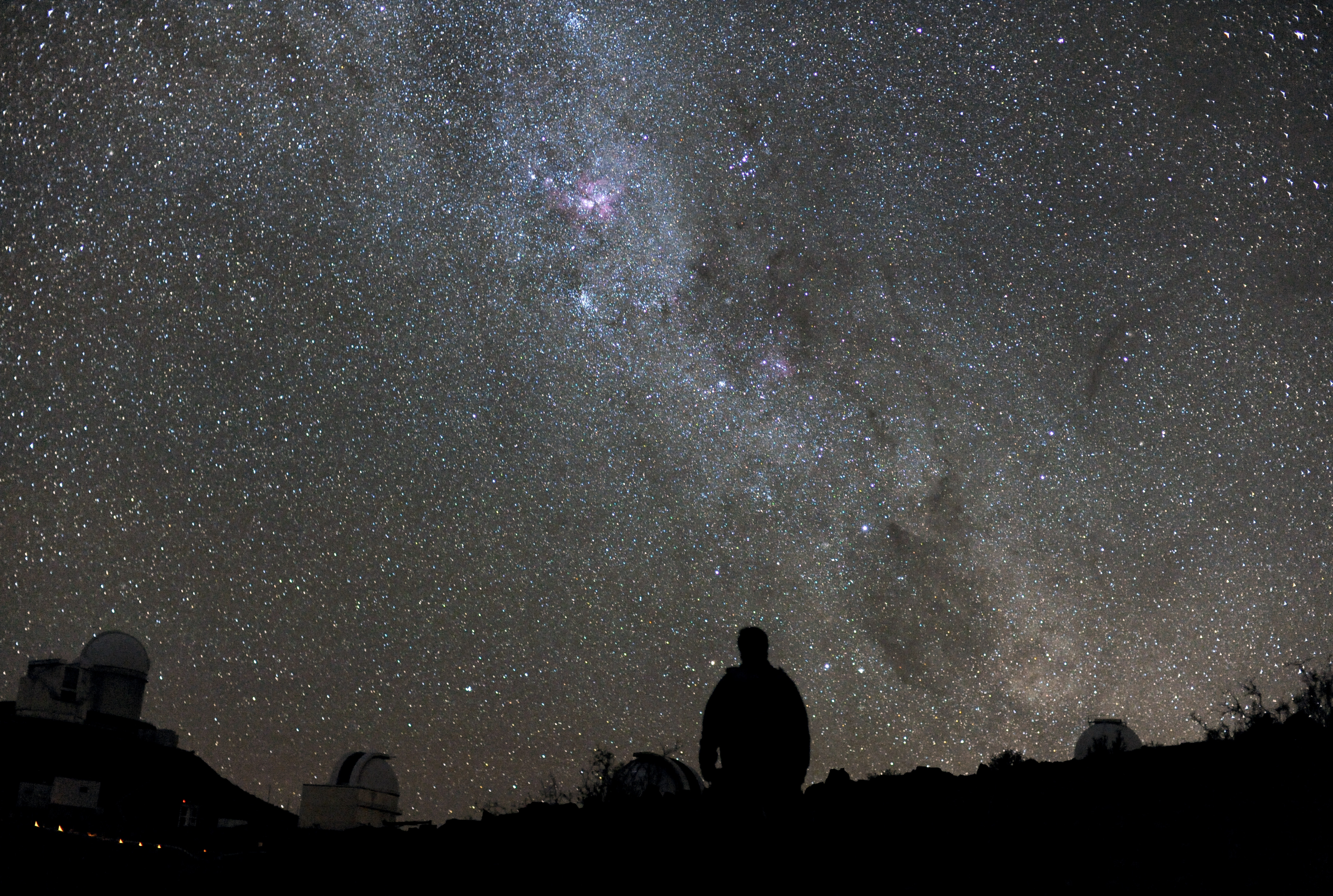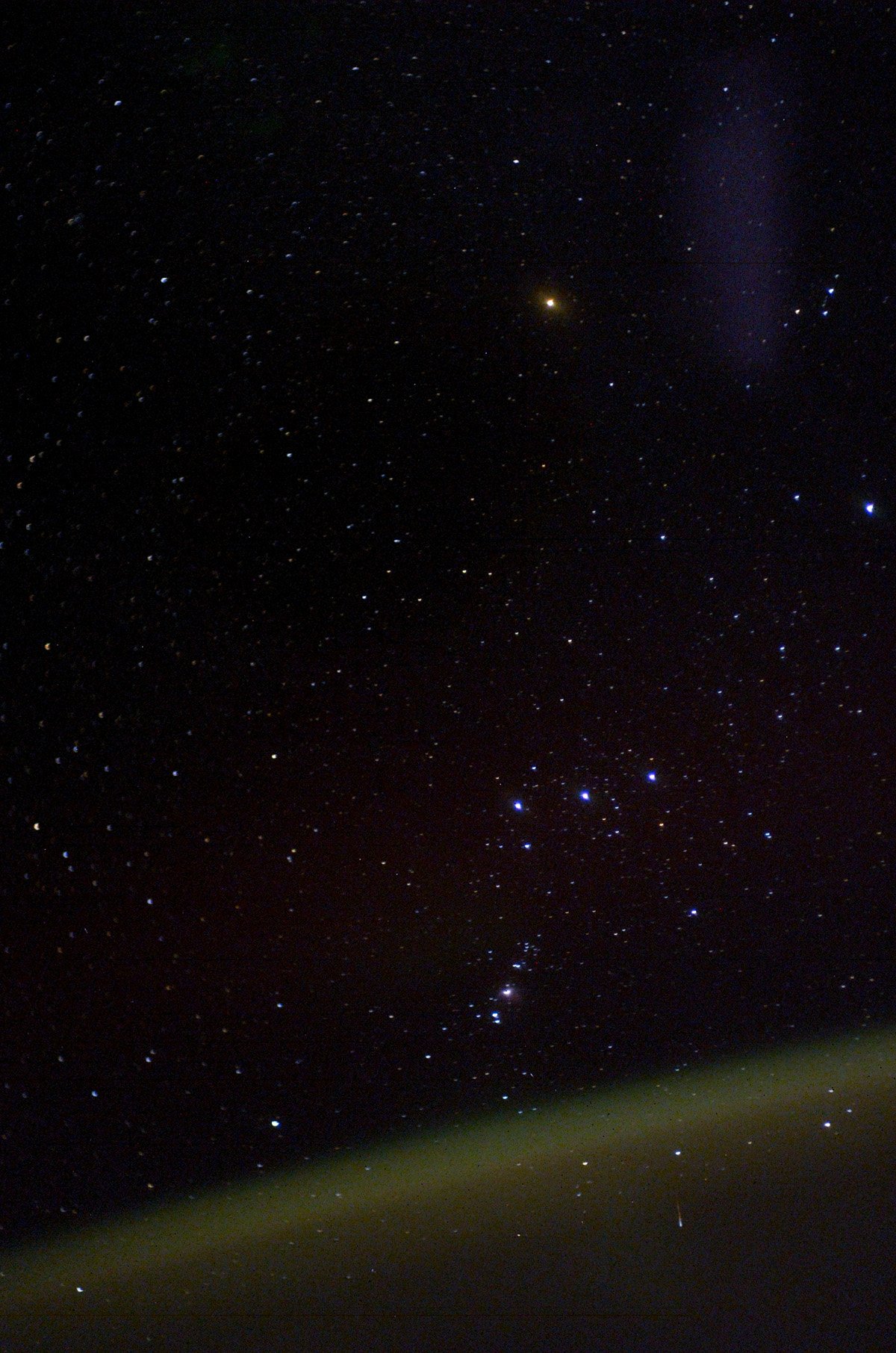|
Night Sky
The night sky is the nighttime appearance of celestial objects like stars, planets, and the Moon, which are visible in a clear sky between sunset and sunrise, when the Sun is below the horizon. Natural light sources in a night sky include moonlight, starlight, and airglow, depending on location and timing. Aurorae light up the skies above the polar circles. Occasionally, a large coronal mass ejection from the Sun or simply high levels of solar wind may extend the phenomenon toward the Equator. The night sky and studies of it have a historical place in both ancient and modern cultures. In the past, for instance, farmers have used the status of the night sky as a calendar to determine when to plant crops. Many cultures have drawn constellations between stars in the sky, using them in association with legends and mythology about their deities. The history of astrology has generally been based on the belief that relationships between heavenly bodies influence or explain events on Ear ... [...More Info...] [...Related Items...] OR: [Wikipedia] [Google] [Baidu] |
Calendar
A calendar is a system of organizing days. This is done by giving names to periods of time, typically days, weeks, months and years. A calendar date, date is the designation of a single and specific day within such a system. A calendar is also a physical record (often paper) of such a system. A calendar can also mean a list of planned events, such as a court calendar, or a partly or fully chronological list of documents, such as a calendar of wills. Periods in a calendar (such as years and months) are usually, though not necessarily, synchronized with the cycle of the solar calendar, sun or the lunar calendar, moon. The most common type of pre-modern calendar was the lunisolar calendar, a lunar calendar that occasionally adds one intercalary month to remain synchronized with the solar year over the long term. Etymology The term ''calendar'' is taken from , the term for the first day of the month in the Roman calendar, related to the verb 'to call out', referring to the " ... [...More Info...] [...Related Items...] OR: [Wikipedia] [Google] [Baidu] |
Rayleigh Scattering
Rayleigh scattering ( ) is the scattering or deflection of light, or other electromagnetic radiation, by particles with a size much smaller than the wavelength of the radiation. For light frequencies well below the resonance frequency of the scattering medium (normal dispersion relation, dispersion regime), the amount of scattering is inversely proportional to the fourth power of the wavelength (e.g., a blue color is scattered much more than a red color as light propagates through air). The phenomenon is named after the 19th-century British physicist Lord Rayleigh (John William Strutt). Rayleigh scattering results from the electric polarizability of the particles. The oscillating electric field of a light wave acts on the charges within a particle, causing them to move at the same frequency. The particle, therefore, becomes a small radiating dipole whose radiation we see as scattered light. The particles may be individual atoms or molecules; it can occur when light travels throu ... [...More Info...] [...Related Items...] OR: [Wikipedia] [Google] [Baidu] |
Starry Night At La Silla
{{Disambiguation ...
Starry may refer to: *Starry (drink), a beverage sold by PepsiCo * ''Starry'' (The Killjoys album), 1994 * ''Starry'' (Purr Machine album), 2007 *Donn A. Starry (1925–2011), United States Army general *Starry Lee (born 1974), Hong Kong politician *Starry Internet, a fixed wireless internet service provider * ''Starry'' (musical), a musical about van Gogh. See also * * *Star (other) A star is a luminous astronomical object. Star, The Star or STAR may also refer to: Shapes and symbols * Star polygon, a geometric shape with acute points arranged radially * Star (glyph), a typographical symbol * Star (heraldry), star-like sh ... [...More Info...] [...Related Items...] OR: [Wikipedia] [Google] [Baidu] |
Skyglow
Skyglow (or sky glow) is the diffuse luminance of the night sky, apart from discrete light sources such as the Moon and visible individual stars. It is a commonly noticed aspect of light pollution. While usually referring to luminance arising from artificial lighting, skyglow may also involve any scattered light seen at night, including natural ones like starlight, zodiacal light, and airglow. In the context of light pollution, skyglow arises from the use of artificial light sources, including electrical (or rarely gas) lighting used for illumination and advertisement and from gas flares. Light propagating into the atmosphere directly from upward-directed or incompletely shielded sources, or after reflection from the ground or other surfaces, is partially scattered back toward the ground, producing a diffuse glow that is visible from great distances. Skyglow from artificial lights is most often noticed as a glowing dome of light over cities and towns, yet is pervasive through ... [...More Info...] [...Related Items...] OR: [Wikipedia] [Google] [Baidu] |
Amateur Astronomers
An amateur () is generally considered a person who pursues an avocation independent from their source of income. Amateurs and their pursuits are also described as popular, informal, self-taught, user-generated, DIY, and hobbyist. History Historically, the amateur was considered to be the ideal balance between pure intent, open mind, and the interest or passion for a subject. That ideology spanned many different fields of interest. It may have its roots in the ancient Greek philosophy of amateur athletes competing in the Olympics. The ancient Greek citizens spent most of their time in other pursuits, but competed according to their natural talents and abilities. The "gentleman amateur" was a phenomenon among the gentry of Great Britain from the 17th century until the 20th century. With the start of the Age of Reason, with people thinking more about how the world works around them, (see science in the Age of Enlightenment), things like the cabinets of curiosities, and ... [...More Info...] [...Related Items...] OR: [Wikipedia] [Google] [Baidu] |
Optical Filter
An optical filter is a device that selectively transmits light of different wavelengths, usually implemented as a glass plane or plastic device in the optical path, which are either dyed in the bulk or have interference coatings. The optical properties of filters are completely described by their frequency response, which specifies how the magnitude and phase of each frequency component of an incoming signal is modified by the filter. Filters mostly belong to one of two categories. The simplest, physically, is the absorptive filter; then there are interference or dichroic filters. Many optical filters are used for optical imaging and are manufactured to be transparent; some used for light sources can be translucent. Optical filters selectively transmit light in a particular range of wavelengths, that is, colours, while absorbing the remainder. They can usually pass long wavelengths only (longpass), short wavelengths only (shortpass), or a band of wavelengths, bloc ... [...More Info...] [...Related Items...] OR: [Wikipedia] [Google] [Baidu] |
Sky Brightness
Sky brightness refers to the visual perception of the sky and how it scatters and diffuses light. The fact that the sky is not completely dark at night is easily visible. If light sources (e.g. the Moon and light pollution) were removed from the night sky, only direct starlight would be visible. The sky's brightness varies greatly over the day, and the primary cause differs as well. During daytime, when the Sun is above the horizon, the direct scattering of sunlight is the overwhelmingly dominant source of light. During twilight (the duration after sunset or before sunrise until or since, respectively, the full darkness of night), the situation is more complicated, and a further differentiation is required. Twilight (both dusk and dawn) is divided into three 6° segments that mark the Sun's position below the horizon. At civil twilight, the center of the Sun's disk appears to be between 1/4° and 6° below the horizon. At nautical twilight, the Sun's altitude is betwee ... [...More Info...] [...Related Items...] OR: [Wikipedia] [Google] [Baidu] |
Light Pollution
Light pollution is the presence of any unwanted, inappropriate, or excessive artificial Visible spectrum, lighting. In a descriptive sense, the term ''light pollution'' refers to the effects of any poorly implemented lighting sources, during the day or night. Light pollution can be understood not only as a phenomenon resulting from a specific source or kind of pollution, but also as a contributor to the wider, collective impact of various sources of pollution. Although this type of pollution can exist throughout the day, its effects are magnified during the night with the contrast of the sky's darkness. It has been estimated that 83% of the world's people live under light-polluted skies and that 23% of the world's land area is affected by skyglow. The area affected by artificial illumination continues to increase. A major side effect of urbanization, light pollution is blamed for compromising health, disrupting ecosystems, and spoiling aesthetic environments. Studies show that ur ... [...More Info...] [...Related Items...] OR: [Wikipedia] [Google] [Baidu] |
Observational Astronomy
Observational astronomy is a division of astronomy that is concerned with recording data about the observable universe, in contrast with theoretical astronomy, which is mainly concerned with calculating the measurable implications of physical models. It is the practice and study of observing celestial objects with the use of telescopes and other astronomical instruments. As a science, the study of astronomy is somewhat hindered in that direct experiments with the properties of the distant universe are not possible. However, this is partly compensated by the fact that astronomers have a vast number of visible examples of stellar phenomena that can be examined. This allows for observational data to be plotted on graphs, and general trends recorded. Nearby examples of specific phenomena, such as variable stars, can then be used to infer the behavior of more distant representatives. Those distant yardsticks can then be employed to measure other phenomena in that neighborhood, inc ... [...More Info...] [...Related Items...] OR: [Wikipedia] [Google] [Baidu] |
History Of Astrology
Astrological belief in relation between celestial observations and terrestrial events have influenced various aspects of human history, including world-views, language and many elements of culture. It has been argued that astrology began as a study as soon as human beings made conscious attempts to measure, record, and predict seasonal changes by reference to astronomical cycles. Early evidence of such practices appears as markings on bones and cave walls, which show that the lunar cycle was being noted as early as 25,000 years ago; the first step towards recording the Moon's influence upon tides and rivers, and towards organizing a communal calendar. With the Neolithic Revolution new needs were also being met by the increasing knowledge of constellations, whose appearances in the night-time sky change with the seasons, thus allowing the rising of particular star-groups to herald annual floods or seasonal activities. By the 3rd millennium BCE, widespread civilisations had deve ... [...More Info...] [...Related Items...] OR: [Wikipedia] [Google] [Baidu] |
Deities
A deity or god is a supernatural being considered to be sacred and worthy of worship due to having authority over some aspect of the universe and/or life. The ''Oxford Dictionary of English'' defines ''deity'' as a God (male deity), god or goddess, or anything revered as divine. C. Scott Littleton defines a deity as "a being with powers greater than those of ordinary humans, but who interacts with humans, positively or negatively, in ways that carry humans to new Higher consciousness, levels of consciousness, beyond the grounded preoccupations of ordinary life". Religions can be categorized by how many deities they worship. Monotheism, Monotheistic religions accept only one deity (predominantly referred to as "God"), whereas Polytheism, polytheistic religions accept multiple deities. Henotheism, Henotheistic religions accept one God, supreme deity without denying other deities, considering them as aspects of the same divine principle. Nontheistic religions deny any supreme eter ... [...More Info...] [...Related Items...] OR: [Wikipedia] [Google] [Baidu] |









